Cognitive Radio Spectrum Auction Mechanism Project - University Name
VerifiedAdded on 2022/10/08
|17
|2205
|24
Project
AI Summary
This project focuses on designing an adaptive auction framework for spectrum markets in cognitive radio (CR) networks. It begins with an introduction to cognitive radio and its challenges in spectrum allocation, emphasizing the use of auction mechanisms to allocate idle spectrum channels. The project details an auction simulator, explaining the generation of random prices, spectrum valuation, and the roles of primary and secondary users. It includes partial code examples for generating random prices, valuations, and defining primary users. The project also covers the coloring algorithm of the spectrum, based on graph algorithms, to monitor the theory with an enhanced algorithm and the use of a simulator robot for spectrum analysis. The winner algorithm, using comparison methods, is described to determine the auction winners. The conclusion highlights the benefits of cognitive radio and the online auction platform for spectrum allocation, contrasting it with traditional auction systems.
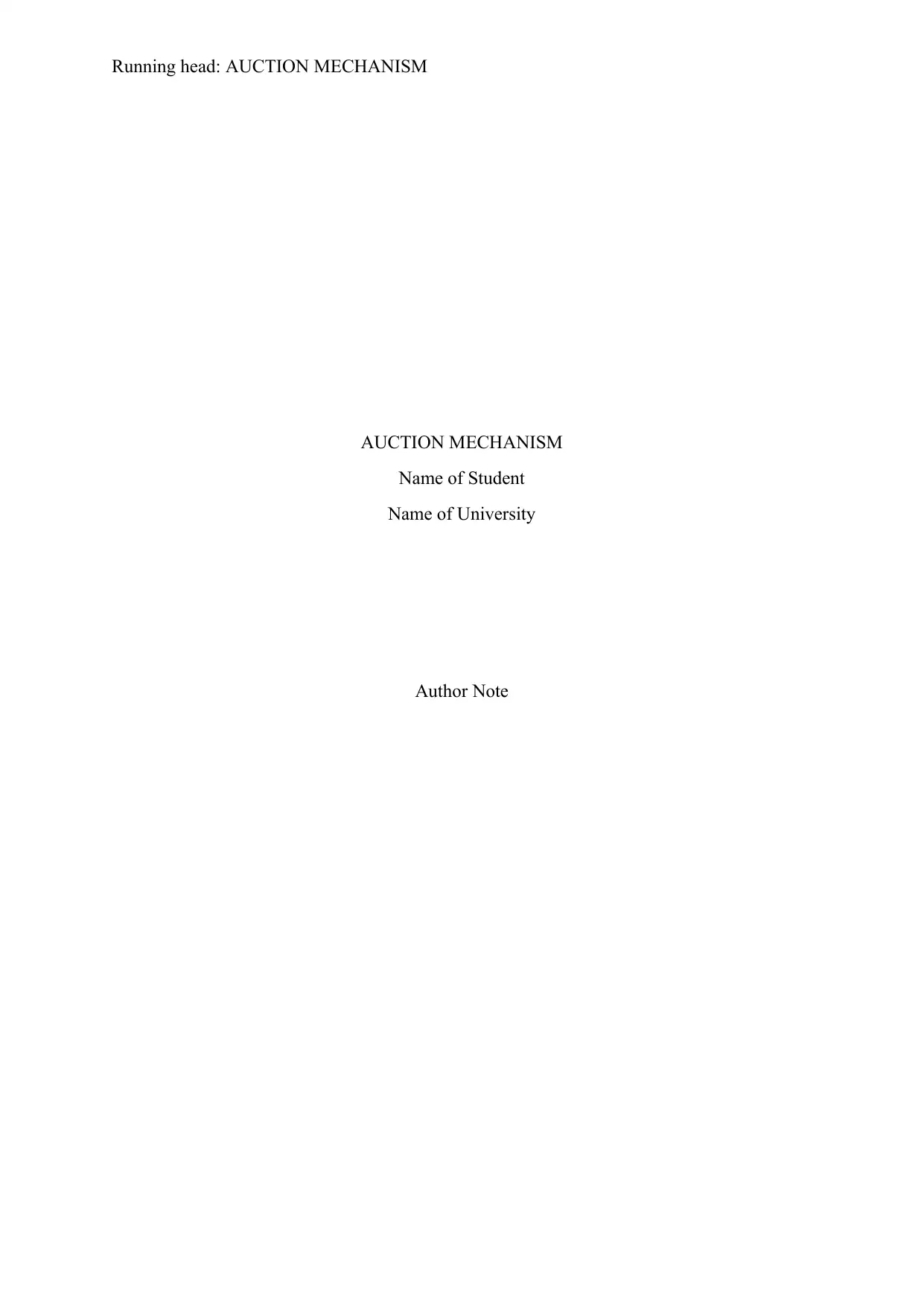
Running head: AUCTION MECHANISM
AUCTION MECHANISM
Name of Student
Name of University
Author Note
AUCTION MECHANISM
Name of Student
Name of University
Author Note
Paraphrase This Document
Need a fresh take? Get an instant paraphrase of this document with our AI Paraphraser
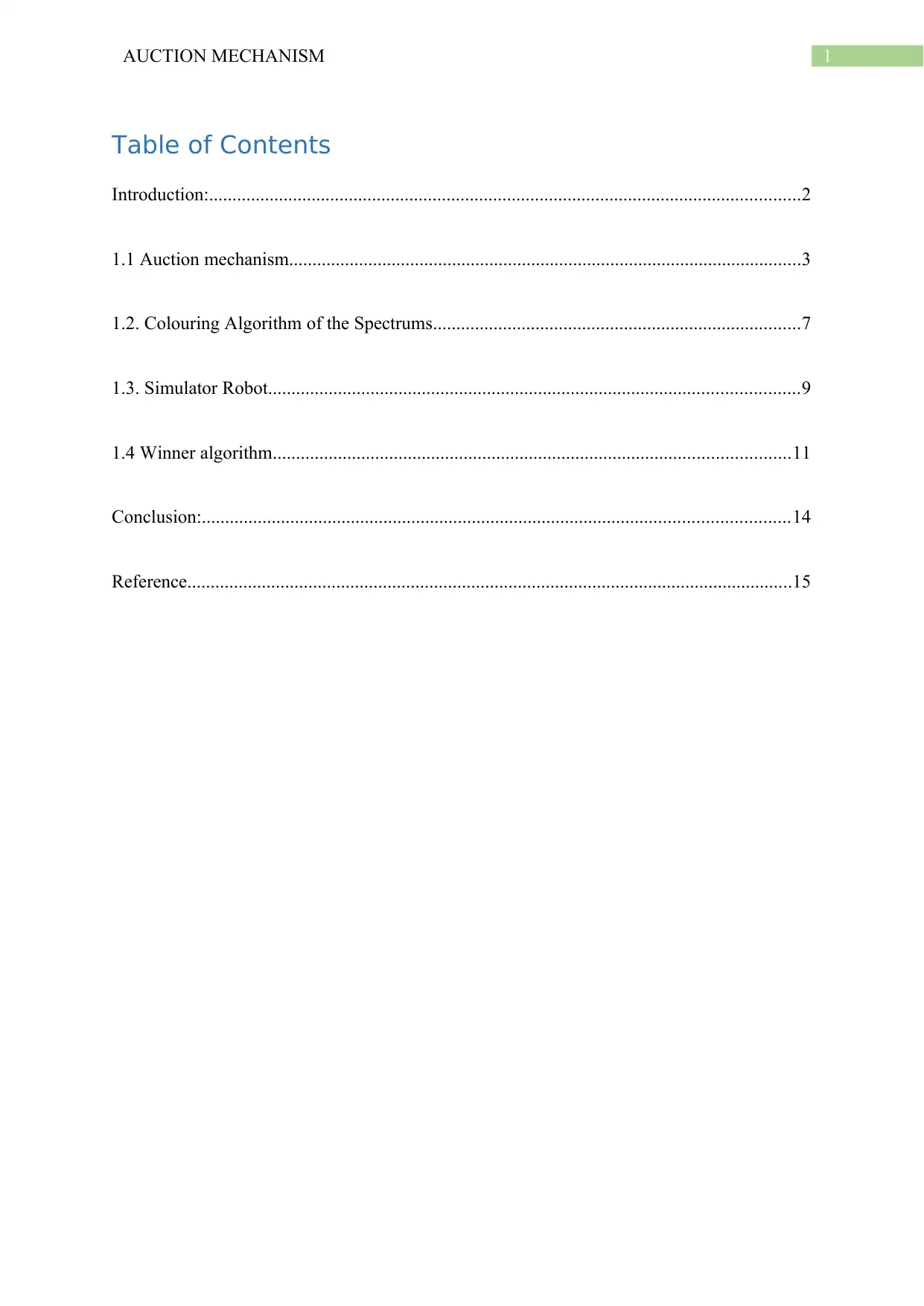
1AUCTION MECHANISM
Table of Contents
Introduction:...............................................................................................................................2
1.1 Auction mechanism..............................................................................................................3
1.2. Colouring Algorithm of the Spectrums...............................................................................7
1.3. Simulator Robot..................................................................................................................9
1.4 Winner algorithm...............................................................................................................11
Conclusion:..............................................................................................................................14
Reference..................................................................................................................................15
Table of Contents
Introduction:...............................................................................................................................2
1.1 Auction mechanism..............................................................................................................3
1.2. Colouring Algorithm of the Spectrums...............................................................................7
1.3. Simulator Robot..................................................................................................................9
1.4 Winner algorithm...............................................................................................................11
Conclusion:..............................................................................................................................14
Reference..................................................................................................................................15
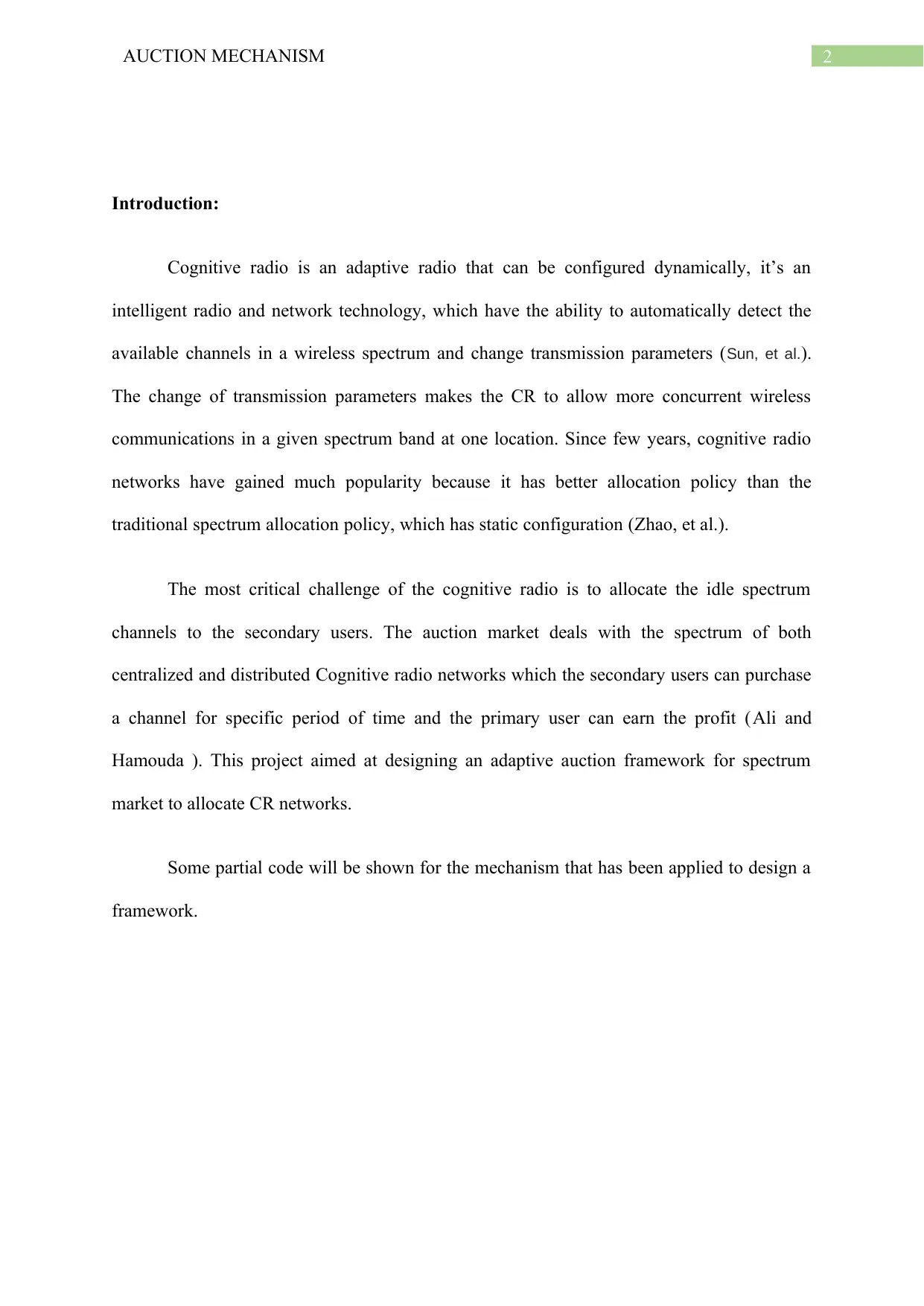
2AUCTION MECHANISM
Introduction:
Cognitive radio is an adaptive radio that can be configured dynamically, it’s an
intelligent radio and network technology, which have the ability to automatically detect the
available channels in a wireless spectrum and change transmission parameters (Sun, et al.).
The change of transmission parameters makes the CR to allow more concurrent wireless
communications in a given spectrum band at one location. Since few years, cognitive radio
networks have gained much popularity because it has better allocation policy than the
traditional spectrum allocation policy, which has static configuration (Zhao, et al.).
The most critical challenge of the cognitive radio is to allocate the idle spectrum
channels to the secondary users. The auction market deals with the spectrum of both
centralized and distributed Cognitive radio networks which the secondary users can purchase
a channel for specific period of time and the primary user can earn the profit (Ali and
Hamouda ). This project aimed at designing an adaptive auction framework for spectrum
market to allocate CR networks.
Some partial code will be shown for the mechanism that has been applied to design a
framework.
Introduction:
Cognitive radio is an adaptive radio that can be configured dynamically, it’s an
intelligent radio and network technology, which have the ability to automatically detect the
available channels in a wireless spectrum and change transmission parameters (Sun, et al.).
The change of transmission parameters makes the CR to allow more concurrent wireless
communications in a given spectrum band at one location. Since few years, cognitive radio
networks have gained much popularity because it has better allocation policy than the
traditional spectrum allocation policy, which has static configuration (Zhao, et al.).
The most critical challenge of the cognitive radio is to allocate the idle spectrum
channels to the secondary users. The auction market deals with the spectrum of both
centralized and distributed Cognitive radio networks which the secondary users can purchase
a channel for specific period of time and the primary user can earn the profit (Ali and
Hamouda ). This project aimed at designing an adaptive auction framework for spectrum
market to allocate CR networks.
Some partial code will be shown for the mechanism that has been applied to design a
framework.
⊘ This is a preview!⊘
Do you want full access?
Subscribe today to unlock all pages.

Trusted by 1+ million students worldwide
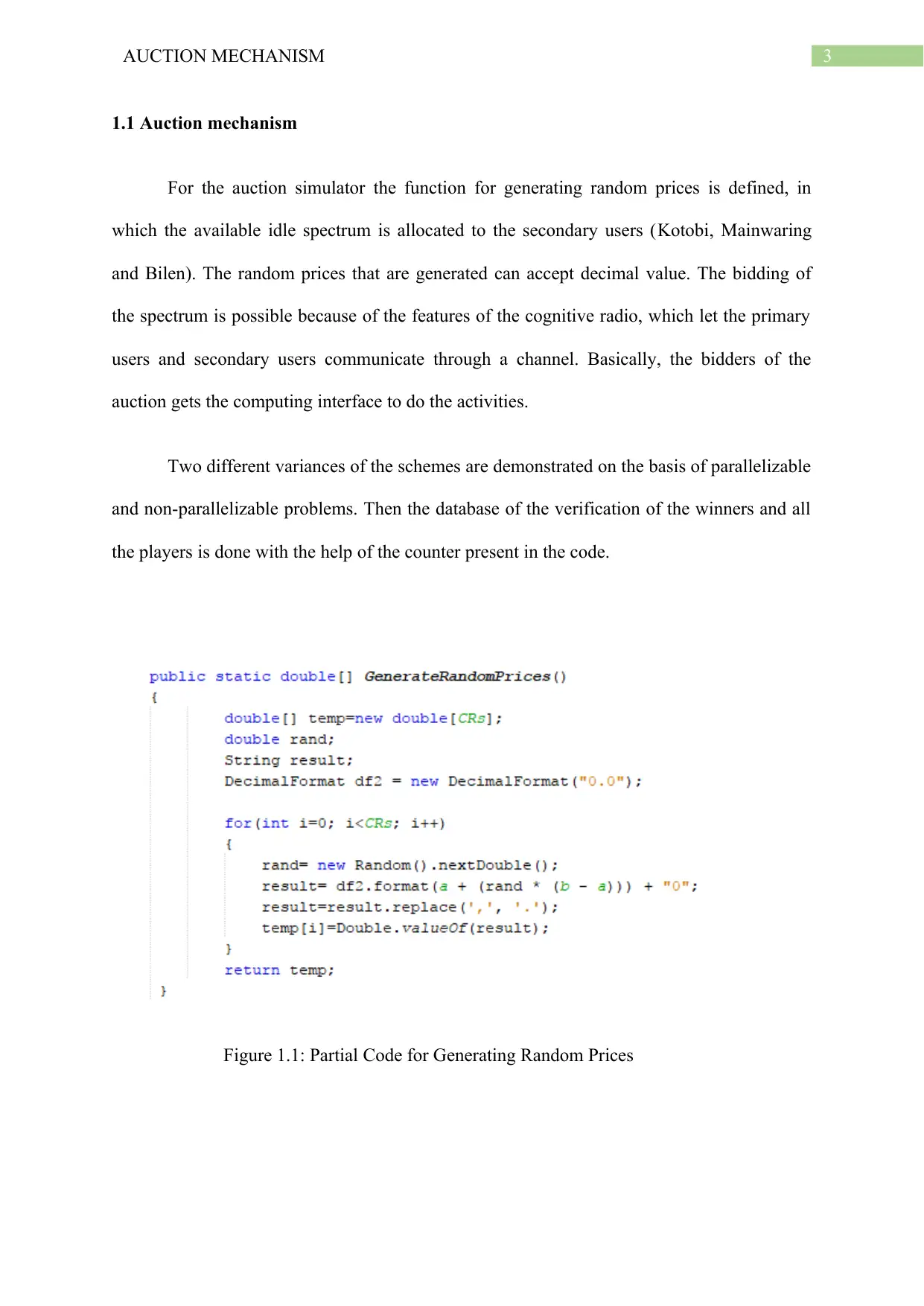
3AUCTION MECHANISM
1.1 Auction mechanism
For the auction simulator the function for generating random prices is defined, in
which the available idle spectrum is allocated to the secondary users (Kotobi, Mainwaring
and Bilen). The random prices that are generated can accept decimal value. The bidding of
the spectrum is possible because of the features of the cognitive radio, which let the primary
users and secondary users communicate through a channel. Basically, the bidders of the
auction gets the computing interface to do the activities.
Two different variances of the schemes are demonstrated on the basis of parallelizable
and non-parallelizable problems. Then the database of the verification of the winners and all
the players is done with the help of the counter present in the code.
Figure 1.1: Partial Code for Generating Random Prices
1.1 Auction mechanism
For the auction simulator the function for generating random prices is defined, in
which the available idle spectrum is allocated to the secondary users (Kotobi, Mainwaring
and Bilen). The random prices that are generated can accept decimal value. The bidding of
the spectrum is possible because of the features of the cognitive radio, which let the primary
users and secondary users communicate through a channel. Basically, the bidders of the
auction gets the computing interface to do the activities.
Two different variances of the schemes are demonstrated on the basis of parallelizable
and non-parallelizable problems. Then the database of the verification of the winners and all
the players is done with the help of the counter present in the code.
Figure 1.1: Partial Code for Generating Random Prices
Paraphrase This Document
Need a fresh take? Get an instant paraphrase of this document with our AI Paraphraser

4AUCTION MECHANISM
After the method for prices is defined, the function for valuation of the spectrum is
defined in which the value of the cognitive radio is shown to the users then the method for
virtual valuation is also defined in the code of the auction.
Fig 1.2: Partial code for Valuations
The information about the primary user is static i.e. cannot be modified and during the
auction the primary users arrives at the beginning. The online auction frame helps to reuse the
channel of the network. The method of Primary user is defined in code consisting of Virtual
valuation and the counter for the Winners is also defined which is used to count the winners
of the auction after the processing of Valuation.
After the method for prices is defined, the function for valuation of the spectrum is
defined in which the value of the cognitive radio is shown to the users then the method for
virtual valuation is also defined in the code of the auction.
Fig 1.2: Partial code for Valuations
The information about the primary user is static i.e. cannot be modified and during the
auction the primary users arrives at the beginning. The online auction frame helps to reuse the
channel of the network. The method of Primary user is defined in code consisting of Virtual
valuation and the counter for the Winners is also defined which is used to count the winners
of the auction after the processing of Valuation.

5AUCTION MECHANISM
Fig 1.3 Partial code for Primary User
Fig 1.4: Partial code for counting the Winners
Fig 1.3 Partial code for Primary User
Fig 1.4: Partial code for counting the Winners
⊘ This is a preview!⊘
Do you want full access?
Subscribe today to unlock all pages.

Trusted by 1+ million students worldwide

6AUCTION MECHANISM
The main function consists of scanner class which reads the Number of Winners then with
the interface of simulator the bid range is provided. For every bid in the auction valuation
range is evaluated by showing the associated prices for respective Cognitive radios (Yi, Cai
and Zhang). When the Utility of the primary user is evaluated, the cognitive radios with
respective primary user can be acknowledged then after the entire process the number of
bidders for the CRs related to the availability of the spectrum is declared as the outcome with
the declaration of the winners (Hyder, Jeitschko and Xiao). The algorithm that are used in the
program serves easy-implementation, fast computation process and as mentioned earlier, easy
access.
Fig. 1.5: outcome of the Auction mechanism
The main function consists of scanner class which reads the Number of Winners then with
the interface of simulator the bid range is provided. For every bid in the auction valuation
range is evaluated by showing the associated prices for respective Cognitive radios (Yi, Cai
and Zhang). When the Utility of the primary user is evaluated, the cognitive radios with
respective primary user can be acknowledged then after the entire process the number of
bidders for the CRs related to the availability of the spectrum is declared as the outcome with
the declaration of the winners (Hyder, Jeitschko and Xiao). The algorithm that are used in the
program serves easy-implementation, fast computation process and as mentioned earlier, easy
access.
Fig. 1.5: outcome of the Auction mechanism
Paraphrase This Document
Need a fresh take? Get an instant paraphrase of this document with our AI Paraphraser
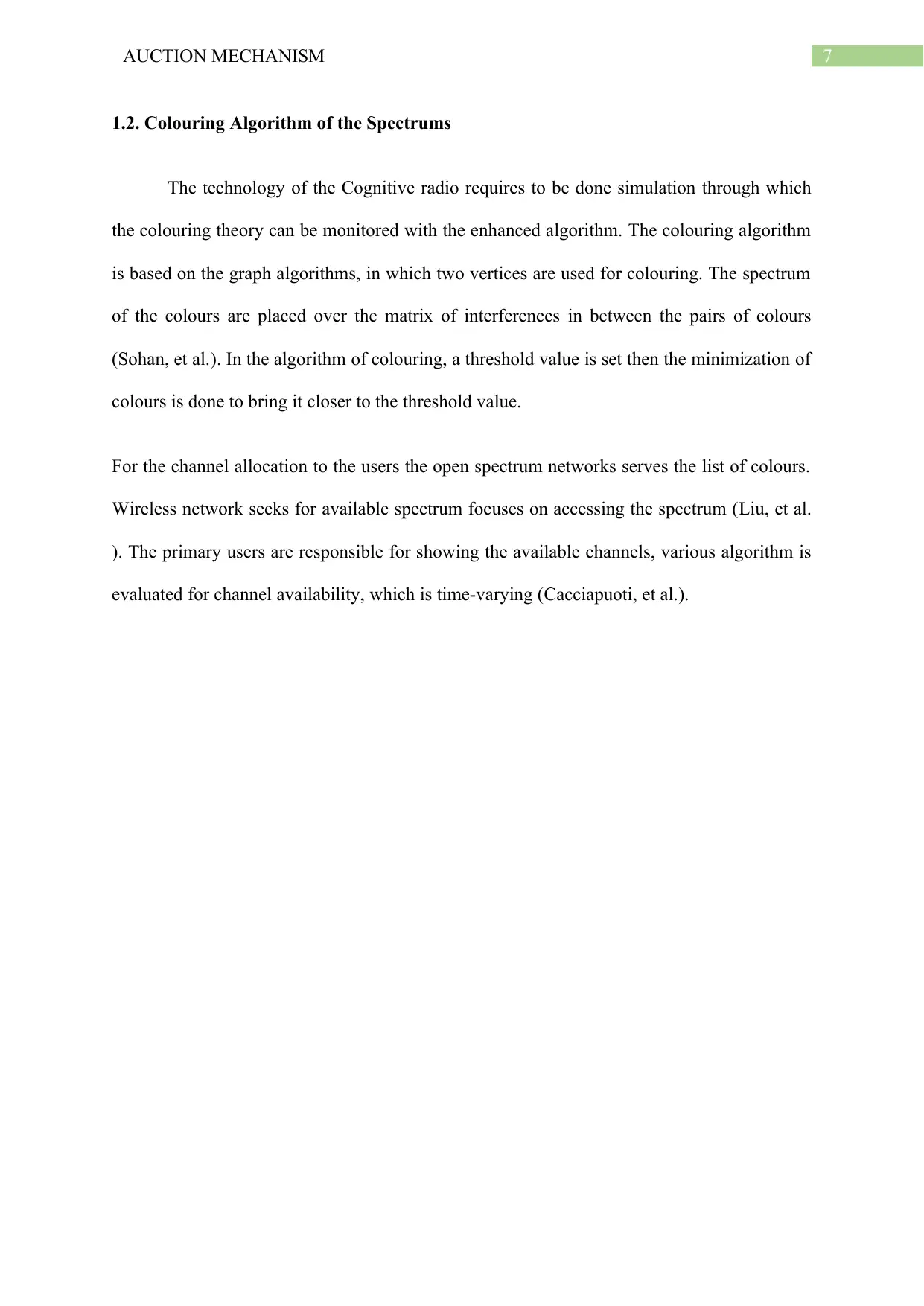
7AUCTION MECHANISM
1.2. Colouring Algorithm of the Spectrums
The technology of the Cognitive radio requires to be done simulation through which
the colouring theory can be monitored with the enhanced algorithm. The colouring algorithm
is based on the graph algorithms, in which two vertices are used for colouring. The spectrum
of the colours are placed over the matrix of interferences in between the pairs of colours
(Sohan, et al.). In the algorithm of colouring, a threshold value is set then the minimization of
colours is done to bring it closer to the threshold value.
For the channel allocation to the users the open spectrum networks serves the list of colours.
Wireless network seeks for available spectrum focuses on accessing the spectrum (Liu, et al.
). The primary users are responsible for showing the available channels, various algorithm is
evaluated for channel availability, which is time-varying (Cacciapuoti, et al.).
1.2. Colouring Algorithm of the Spectrums
The technology of the Cognitive radio requires to be done simulation through which
the colouring theory can be monitored with the enhanced algorithm. The colouring algorithm
is based on the graph algorithms, in which two vertices are used for colouring. The spectrum
of the colours are placed over the matrix of interferences in between the pairs of colours
(Sohan, et al.). In the algorithm of colouring, a threshold value is set then the minimization of
colours is done to bring it closer to the threshold value.
For the channel allocation to the users the open spectrum networks serves the list of colours.
Wireless network seeks for available spectrum focuses on accessing the spectrum (Liu, et al.
). The primary users are responsible for showing the available channels, various algorithm is
evaluated for channel availability, which is time-varying (Cacciapuoti, et al.).
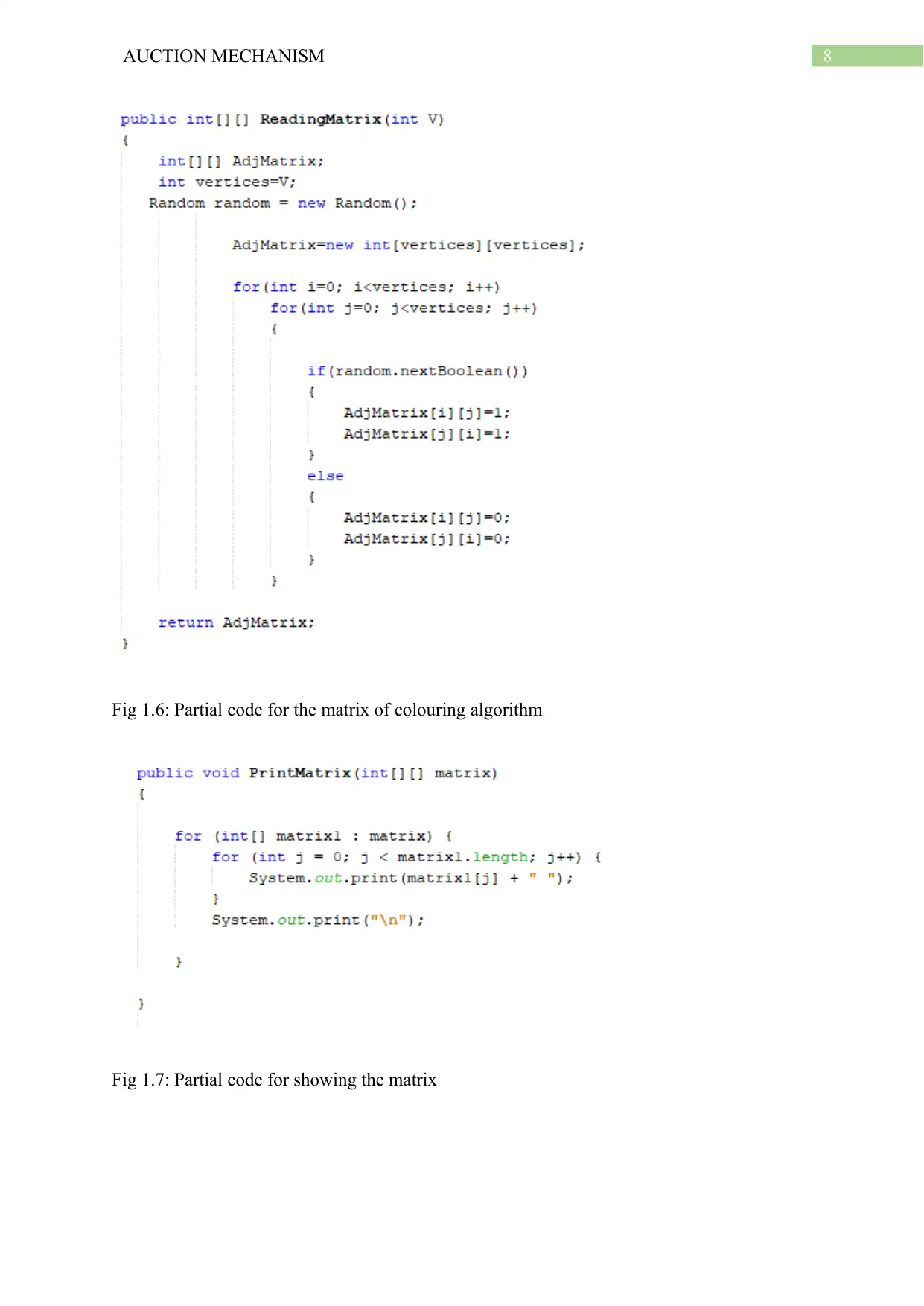
8AUCTION MECHANISM
Fig 1.6: Partial code for the matrix of colouring algorithm
Fig 1.7: Partial code for showing the matrix
Fig 1.6: Partial code for the matrix of colouring algorithm
Fig 1.7: Partial code for showing the matrix
⊘ This is a preview!⊘
Do you want full access?
Subscribe today to unlock all pages.

Trusted by 1+ million students worldwide
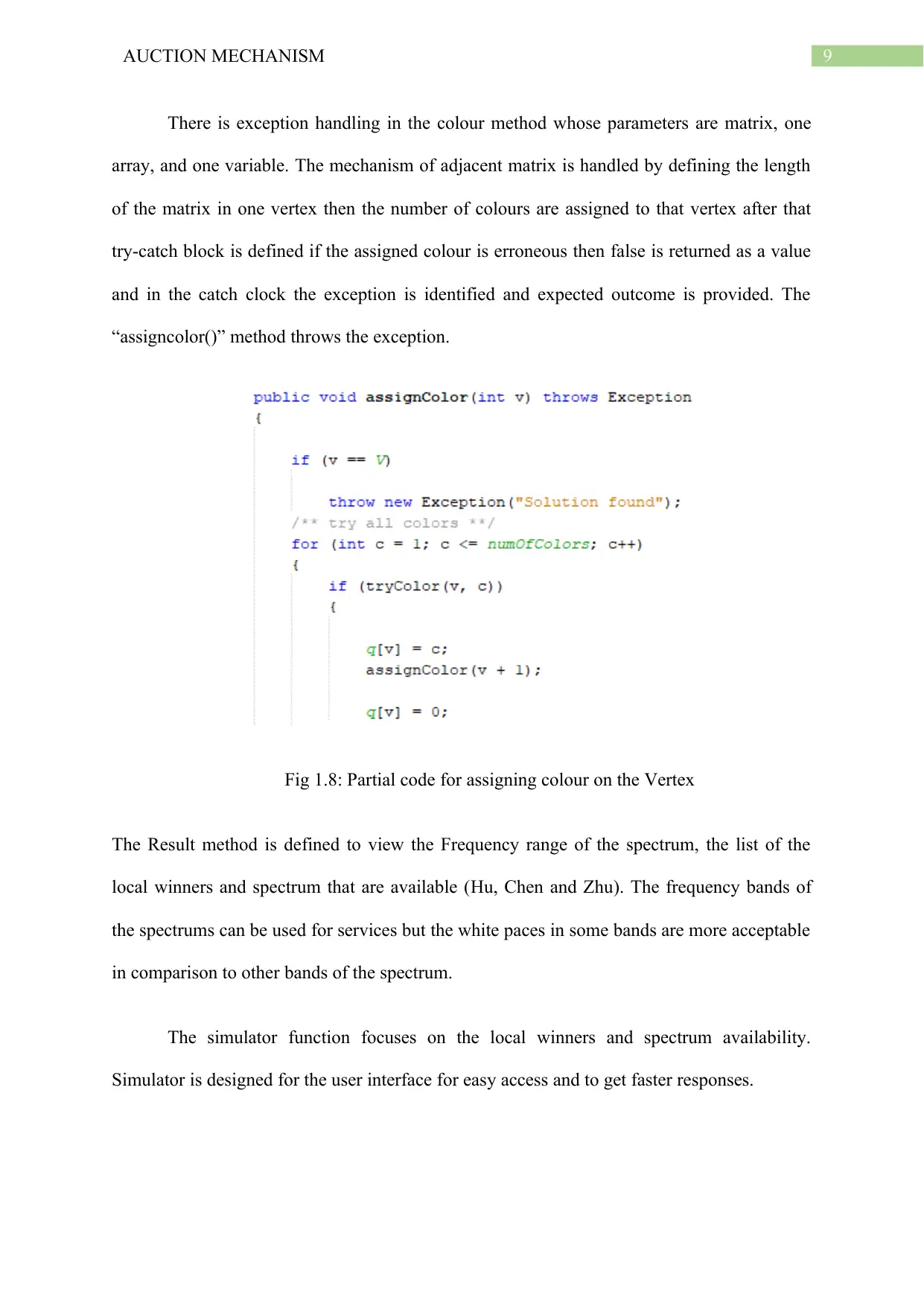
9AUCTION MECHANISM
There is exception handling in the colour method whose parameters are matrix, one
array, and one variable. The mechanism of adjacent matrix is handled by defining the length
of the matrix in one vertex then the number of colours are assigned to that vertex after that
try-catch block is defined if the assigned colour is erroneous then false is returned as a value
and in the catch clock the exception is identified and expected outcome is provided. The
“assigncolor()” method throws the exception.
Fig 1.8: Partial code for assigning colour on the Vertex
The Result method is defined to view the Frequency range of the spectrum, the list of the
local winners and spectrum that are available (Hu, Chen and Zhu). The frequency bands of
the spectrums can be used for services but the white paces in some bands are more acceptable
in comparison to other bands of the spectrum.
The simulator function focuses on the local winners and spectrum availability.
Simulator is designed for the user interface for easy access and to get faster responses.
There is exception handling in the colour method whose parameters are matrix, one
array, and one variable. The mechanism of adjacent matrix is handled by defining the length
of the matrix in one vertex then the number of colours are assigned to that vertex after that
try-catch block is defined if the assigned colour is erroneous then false is returned as a value
and in the catch clock the exception is identified and expected outcome is provided. The
“assigncolor()” method throws the exception.
Fig 1.8: Partial code for assigning colour on the Vertex
The Result method is defined to view the Frequency range of the spectrum, the list of the
local winners and spectrum that are available (Hu, Chen and Zhu). The frequency bands of
the spectrums can be used for services but the white paces in some bands are more acceptable
in comparison to other bands of the spectrum.
The simulator function focuses on the local winners and spectrum availability.
Simulator is designed for the user interface for easy access and to get faster responses.
Paraphrase This Document
Need a fresh take? Get an instant paraphrase of this document with our AI Paraphraser
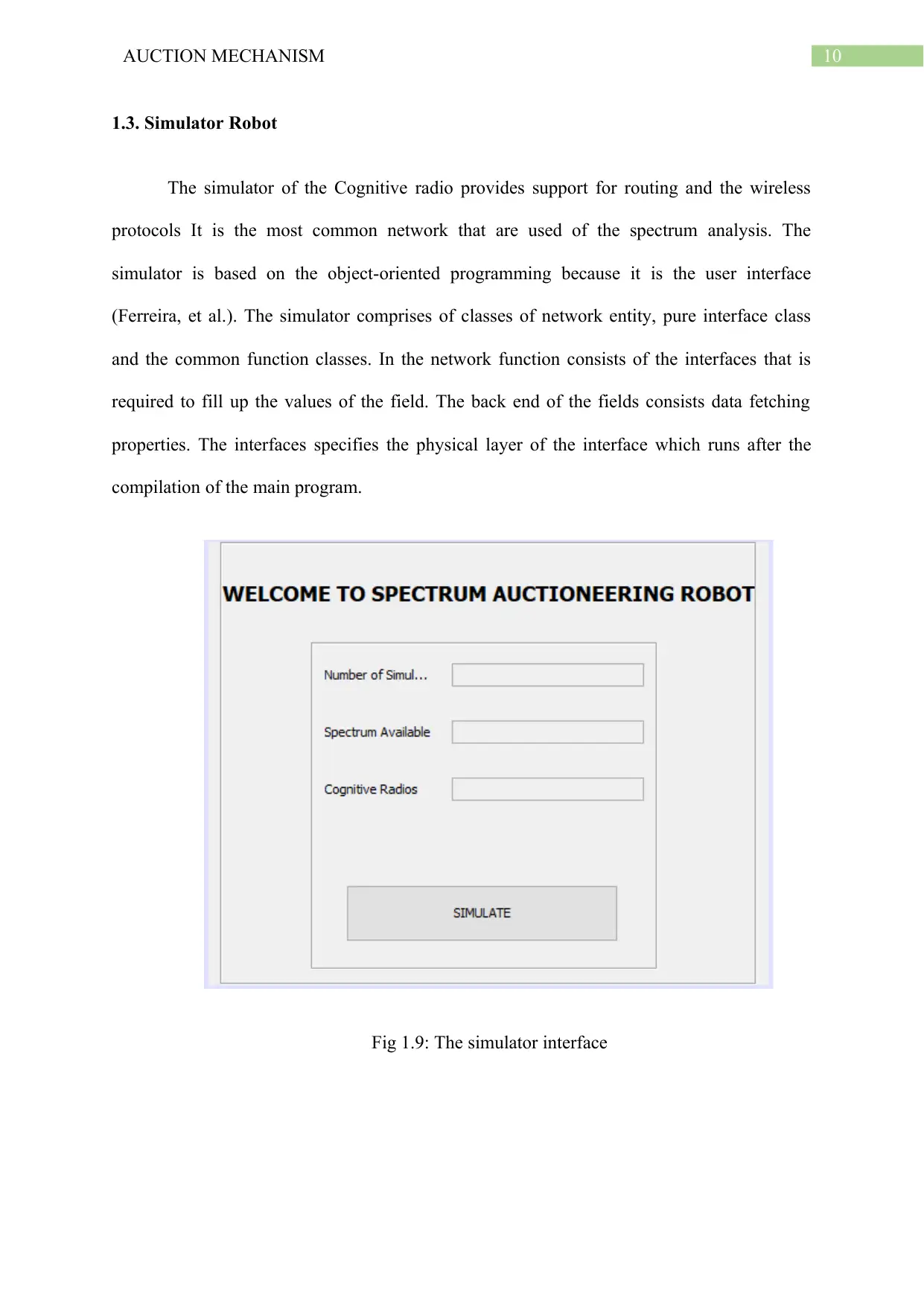
10AUCTION MECHANISM
1.3. Simulator Robot
The simulator of the Cognitive radio provides support for routing and the wireless
protocols It is the most common network that are used of the spectrum analysis. The
simulator is based on the object-oriented programming because it is the user interface
(Ferreira, et al.). The simulator comprises of classes of network entity, pure interface class
and the common function classes. In the network function consists of the interfaces that is
required to fill up the values of the field. The back end of the fields consists data fetching
properties. The interfaces specifies the physical layer of the interface which runs after the
compilation of the main program.
Fig 1.9: The simulator interface
1.3. Simulator Robot
The simulator of the Cognitive radio provides support for routing and the wireless
protocols It is the most common network that are used of the spectrum analysis. The
simulator is based on the object-oriented programming because it is the user interface
(Ferreira, et al.). The simulator comprises of classes of network entity, pure interface class
and the common function classes. In the network function consists of the interfaces that is
required to fill up the values of the field. The back end of the fields consists data fetching
properties. The interfaces specifies the physical layer of the interface which runs after the
compilation of the main program.
Fig 1.9: The simulator interface
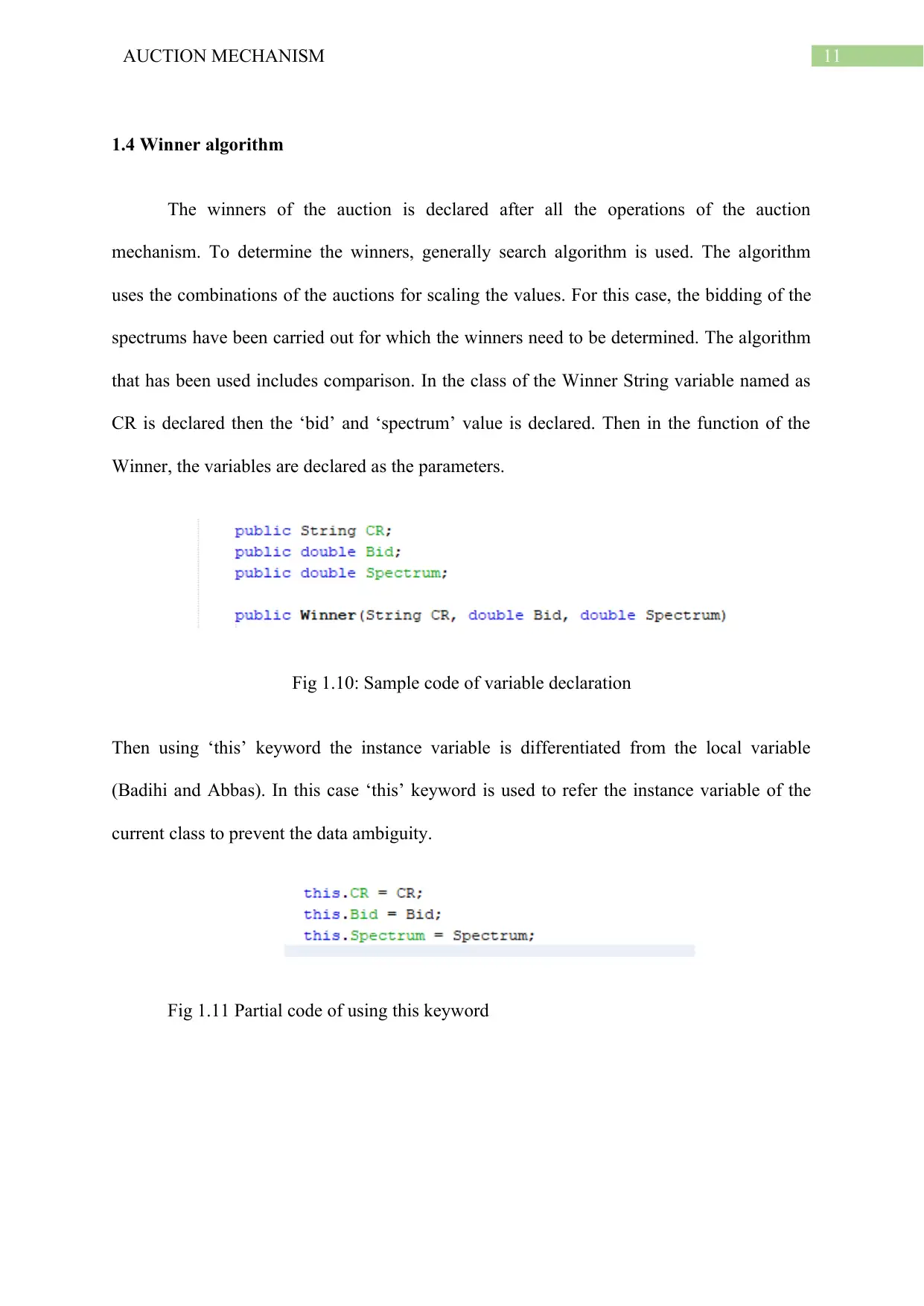
11AUCTION MECHANISM
1.4 Winner algorithm
The winners of the auction is declared after all the operations of the auction
mechanism. To determine the winners, generally search algorithm is used. The algorithm
uses the combinations of the auctions for scaling the values. For this case, the bidding of the
spectrums have been carried out for which the winners need to be determined. The algorithm
that has been used includes comparison. In the class of the Winner String variable named as
CR is declared then the ‘bid’ and ‘spectrum’ value is declared. Then in the function of the
Winner, the variables are declared as the parameters.
Fig 1.10: Sample code of variable declaration
Then using ‘this’ keyword the instance variable is differentiated from the local variable
(Badihi and Abbas). In this case ‘this’ keyword is used to refer the instance variable of the
current class to prevent the data ambiguity.
Fig 1.11 Partial code of using this keyword
1.4 Winner algorithm
The winners of the auction is declared after all the operations of the auction
mechanism. To determine the winners, generally search algorithm is used. The algorithm
uses the combinations of the auctions for scaling the values. For this case, the bidding of the
spectrums have been carried out for which the winners need to be determined. The algorithm
that has been used includes comparison. In the class of the Winner String variable named as
CR is declared then the ‘bid’ and ‘spectrum’ value is declared. Then in the function of the
Winner, the variables are declared as the parameters.
Fig 1.10: Sample code of variable declaration
Then using ‘this’ keyword the instance variable is differentiated from the local variable
(Badihi and Abbas). In this case ‘this’ keyword is used to refer the instance variable of the
current class to prevent the data ambiguity.
Fig 1.11 Partial code of using this keyword
⊘ This is a preview!⊘
Do you want full access?
Subscribe today to unlock all pages.

Trusted by 1+ million students worldwide
1 out of 17
Your All-in-One AI-Powered Toolkit for Academic Success.
+13062052269
info@desklib.com
Available 24*7 on WhatsApp / Email
![[object Object]](/_next/static/media/star-bottom.7253800d.svg)
Unlock your academic potential
Copyright © 2020–2025 A2Z Services. All Rights Reserved. Developed and managed by ZUCOL.